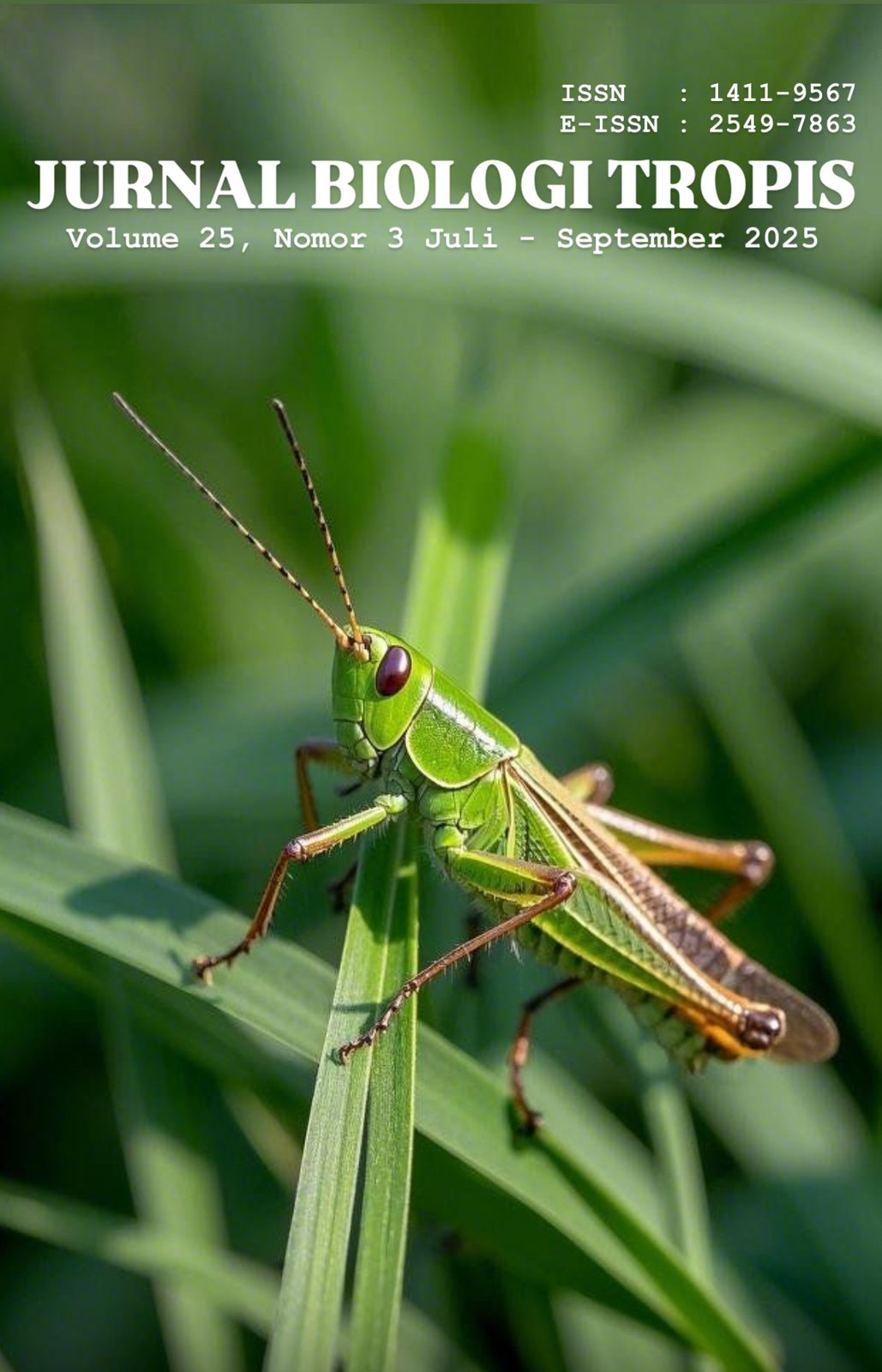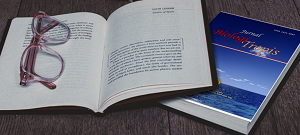Effect of Lemongrass Essential Oil on Gelatin Edible Film: Water Vapor Transmission, Gelation, and Chemical Structure
Authors
Fahrullah Fahrullah , Abidatur RosidaDOI:
10.29303/jbt.v25i3.9124Published:
2025-07-09Issue:
Vol. 25 No. 3 (2025): Juli-SeptemberKeywords:
Edible Film, essential oil, FTIR, gelatin, lemongrass.Articles
Downloads
How to Cite
Downloads
Metrics
Abstract
Edible film constitutes a thin layer that is capable of biodegradation and is therefore considered safe for consumption, thus providing a more environmentally friendly alternative to conventional plastics. The objective of the present study was to ascertain the impact of lemongrass essential oil incorporation on the water vapour transmission rate, gelation time and chemical structure of gelatin edible film. The present study employed a randomised experiment, incorporating 3 distinct treatments and 3 replicates for each treatment. The treatments comprised three groups: P1, which did not include the addition of lemongrass essential oil; P2, which incorporated the addition of lemongrass essential oil at a rate of 4%; and P3, which incorporated the addition of lemongrass essential oil at a rate of 8%. The findings demonstrated that the incorporation of lemongrass essential oil did not exert a substantial influence on the WVTR value (P > 0.05), with the mean value remaining within the parameters stipulated by the Japanese Industrial Standard. Conversely, the gelation time exhibited a significant increase (P<0.01) with rising lemongrass oil concentrations, attributable to the disruption of gelatin intermolecular bonds. FTIR analysis demonstrated interactions between the film components, with an increase in the intensity of certain functional groups indicating alterations in the chemical structure, particularly at a concentration of 4%, which resulted in optimal interactions without compromising the gelatin protein structure. The study concluded that the incorporation of lemongrass oil at concentrations up to 4% yielded optimal outcomes in enhancing the flexibility and antimicrobial properties of edible film, without compromising its structural stability.
References
ASTM E 96. (1995). Standard Test Methods for Water Vapor Transmission of Materials, E 96/E 96M - 05. ASTM International.
Cardoso G. P., Dutra M. P., Fontes P. R., Ramos A. de L. S., Gomide L. A. de M., & Ramos E. M. (2016). Selection of a chitosan gelatin-based edible coating for color preservation of beef in retail display. Meat Science, 114. https://doi.org/10.1016/j.meatsci.2015.12.012
Chen C., Xu Z., Ma Y., Liu J., Zhang Q., Tang Z., Fu K., Yang F., & Xie J. (2018). Properties, vapour-phase antimicrobial and antioxidant activities of active poly(vinyl alcohol) packaging films incorporated with clove oil. Food Control, 88. https://doi.org/10.1016/j.foodcont.2017.12.039
Chowdhury S. N., Nag S., Ashish., & Tripathi, K. M. (2017). Recent advances in bio-polymers for innovative food packaging. Biopolymers: Structure, Performance and Applications.
Fahrullah F., Ervandi M., Indrianti M. A., Suparwata D. O., Yasin I. A., Gobel Y. A., Mokoolang S., & Mokoginta M. M. (2021). Mechanical properties of whey composite edible film with the addition of clove essential oil and different types of plasticizer. IOP Conference Series: Earth and Environmental Science, 755(1). https://doi.org/10.1088/1755-1315/755/1/012004
Fahrullah F., Radiati L. E., Purwadi P., & Rosyidi D. (2020). The physical characteristics of whey based edible film added with konjac. Current Research in Nutrition and Food Science, 8(1). https://doi.org/10.12944/CRNFSJ.8.1.31
Fahrullah F., & Ervandi M. (2022). Karakterisasi mikrostruktur film whey dengan penambahan konjac glucomannan. Agrointek : Jurnal Teknologi Industri Pertanian, 16(3), 403–411. https://doi.org/10.21107/agrointek.v16i3.12303
Fahrullah F., Kisworo D., Bulkaini B., Haryanto H., Wulandani B. R. D., Yulianto W., Noersidiq A., & Maslami V. (2023). The effects of plasticizer types on properties of whey-gelatin films. Jurnal Biologi Tropis, 23(3), 414–421. https://doi.org/10.29303/jbt.v23i3.5283
Fahrullah F., Noersidiq A., Kisworo D., & Maruddin F. (2024). Evaluating physicochemical properties of whey-chia seed edible films for biodegradable packaging. Tropical Animal Science Journal, 47(4), 519–528. https://doi.org/10.5398/TASJ.2024.47.4.519
Galus S., & Lenart A. (2019). Optical, mechanical, and moisture sorption properties of whey protein edible films. Journal of Food Process Engineering, 42(6). https://doi.org/10.1111/jfpe.13245
Guerrero P., & de la Caba K. (2017). Protein-based films and coatings. Edible Food Packaging: Materials and Processing Technologies. https://doi.org/10.1201/b19468
Herrera‐vázquez S. E., Dublán‐garcía O., Arizmendi‐cotero D., Gómez‐oliván L. M., Islas‐flores H., Hernández‐navarro M. D., & Ramírez‐durán N. (2022). Optimization of the physical, optical and mechanical properties of composite edible films of gelatin, whey protein and chitosan. Molecules, 27(3). https://doi.org/10.3390/molecules27030869
Hosseini S. F., Rezaei M., Zandi M., & Farahmandghavi F. (2016). Development of bioactive fish gelatin/chitosan nanoparticles composite films with antimicrobial properties. Food Chemistry, 194. https://doi.org/10.1016/j.foodchem.2015.09.004
Jafari B., Ebadi, A., Mohammadiaghdam B., & Hassanzade Z. (2013). Effects of antibacterial activities methanol ofextract and lemon grass essence on pathogenic bacteria. World Applied Sciences Journal, 28(11). https://doi.org/10.5829/idosi.wasj.2013.28.11.1860
Kumar N., Pratibha, P. J., Yadav A., Upadhyay A., Neeraj S. S., Petkoska A. T., Heena S. S., Gniewosz M., & Kieliszek M. (2023). Recent trends in edible packaging for food applications- perspective for the future. In Food Engineering Reviews, 15(4). https://doi.org/10.1007/s12393-023-09358-y
Li J. H., Miao J., Wu J. L., Chen S. F., & Zhang Q. Q. (2014). Preparation and characterization of active gelatin-based films incorporated with natural antioxidants. Food Hydrocolloids, 37. https://doi.org/10.1016/j.foodhyd.2013.10.015
Maruddin F., Ratmawati R., Fahrullah F., & Taufik M. (2018). Karakterisitik edible film berbahan whey dangke dengan penambahan karagenan. Jurnal Veteriner, 19(2). https://doi.org/10.19087/jveteriner.2018.19.2.291
Mihalca V., Kerezsi A. D., Weber A., Grubertraub C., Schmucker J., Vodnar D. C., Dulf F. V., Socaci S. A., Fărcaș A., Mureșan C. I., Suharoschi R., & Pop O. L. (2021). Protein‐based films and coatings for food industry applications. In Polymers, 13(5). https://doi.org/10.3390/polym13050769
Moghadam M., Salami M., Mohammadian M., Khodadadi M., & Emam-Djomeh Z. (2020). Development of antioxidant edible films based on mung bean protein enriched with pomegranate peel. Food Hydrocolloids, 104. https://doi.org/10.1016/j.foodhyd.2020.105735
Murrieta-Martínez C. L., Soto-Valdez H., Pacheco-Aguilar R., Torres-Arreola W., Rodríguez-Felix F., & Ríos E. M. (2018). Edible protein films: Sources and behavior. Packaging Technology and Science, 31(3). https://doi.org/10.1002/pts.2360
Othman F., Idris S. N., Nasir N. A. H. A., & Nawawi M. A. (2022). Preparation and characterization of sodium alginate-based edible film with antibacterial additive using lemongrass oil. Sains Malaysiana, 51(2). https://doi.org/10.17576/jsm-2022-5102-13
Rajeshwar M. S. (2021). Development and application of edible film with bioactive compound. International Journal of Food Science, Nutrition and Dietetics, 10(2):524-531. https://doi.org/10.19070/2326-3350-2100091
Shivangi S., Dorairaj D., Negi P. S., & Shetty N. P. (2021). Development and characterisation of a pectin-based edible film that contains mulberry leaf extract and its bio-active components. Food Hydrocolloids, 121. https://doi.org/10.1016/j.foodhyd.2021.107046
Sucipta I. N., Suriasih K., & Kencana P. K. D. (2020). Pengemasan pangan: Kajian pengemasan yang aman, nyaman, efektif dan efisien. Udayana University Press.
V A. K., Hasan M., Mangaraj S., M, P., Verma D. K., & Srivastav P. P. (2022). Trends in edible packaging films and its prospective future in food: A Review. Applied Food Research, 2(1). https://doi.org/10.1016/j.afres.2022.100118
Wang L., Auty M. A. E., & Kerry J. P. (2010). Physical assessment of composite biodegradable films manufactured using whey protein isolate, gelatin and sodium alginate. Journal of Food Engineering, 96(2). https://doi.org/10.1016/j.jfoodeng.2009.07.025
Yousuf B., Qadri O. S., & Srivastava A. K. (2018). Recent developments in shelf-life extension of fresh-cut fruits and vegetables by application of different edible coatings: A review. In LWT (Vol. 89). https://doi.org/10.1016/j.lwt.2017.10.051
License
Copyright (c) 2025 Fahrullah Fahrullah, Abidatur Rosida

This work is licensed under a Creative Commons Attribution 4.0 International License.

Jurnal Biologi Tropis is licensed under a Creative Commons Attribution 4.0 International License.
The copyright of the received article shall be assigned to the author as the owner of the paper. The intended copyright includes the right to publish the article in various forms (including reprints). The journal maintains the publishing rights to the published articles.
Authors are permitted to disseminate published articles by sharing the link/DOI of the article at the journal. Authors are allowed to use their articles for any legal purposes deemed necessary without written permission from the journal with an acknowledgment of initial publication to this journal.


























